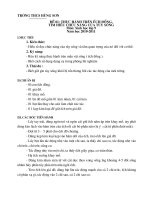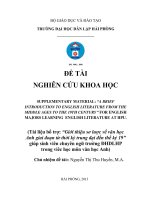powerpoint thuyết trình môn văn học anh
Bạn đang xem bản rút gọn của tài liệu. Xem và tải ngay bản đầy đủ của tài liệu tại đây (2.94 MB, 42 trang )
MIDDLE ENGLISH LITERATURE
( 1066- 1485)
6/4/15 1
By group 1:
I. Historical
background
II. Literature
Geoffrey Chaucer
The Canterbury
Tales
III. Review
6/4/15 2
The Norman conquest led by William
the conqueror
•
The Norman conquest of England was
the 11th-century invasion and
occupation of England by an army of
Norman, Breton, and French soldiers led
by Duke William II of Normandy, later
William the Conqueror.
•
The Norman conquest led by William
the conqueror began in 25 September
1066.
•
Within days, William landed in southern
England. Harold marched south to
confront him, leaving a significant
portion of his army in the north.
Harold's army confronted William's
invaders on 14 October at the Battle of
Hastings; William's force defeated
Harold, who was killed in the
engagement. The Battle of Hasting
ended last Saxon kings. Then William,
ducke of Normandy became
6/4/15 3
•
The Magna Carta is a document that
King John of England (1166 - 1216) was
forced into signing. King John was forced
into signing the charter because it greatly
reduced the power he held as the King of
England and allowed for the formation of
a powerful parliament. The Magna Carta
became the basis for English citizen's
rights.
•
The content of the Magna Carta was
drafted by Archbishop Stephen Langton
and the most powerful Barons of
England. King John signed the document
which was originally called the 'Articles
of the Barons' on June 10, 1215.Other
names for Magna Carta: It is also
referred to as the Magna Charter or the
Great Charter
•
The Magna Carta was signed by King
John in a meadow at Runnymede in
Egham, Surrey, South England ( between
Windsor and Staines)
King john was forced to sign the
magna carta (1215).
6/4/15
4
The Hundred Years' War was a long struggle
between England and France over succession
to the French throne. It lasted from 1337 to
1453, so it might more accurately be called
the "116 Years' War." The war starts off with
several stunning successes on Britain's part,
and the English forces dominate France for
decades. Then, the struggle see-saws back and
forth. In the 1360s, the French are winning.
From 1415-1422, the English are winning.
After 1415, King Henry V of England revives
the campaign and he conquers large portions
of France, winning extraordinary political
concessions. From 1422 onward, however, the
French crown strikes back. The teenage girl
Jeanne d'Arc (Joan of Arc), a remarkable
young mystic, leads the French troops to
reclaim their lands
6/4/15 5
The Hundred Years' War began.
Henry v
Jeanne ‘ Arc
6/4/15 6
6/4/15 7
1348-1349.Black Death Struck England
6/4/15 8
The Black Death, a bubonic plague pandemic which
reached Europe in 1347 spread to England in 1348, and
killed between a third and more than half of the nation's
inhabitants.
6/4/15 9
Originating in China, it spread west along
the trade routes across Europe and arrived on
the British Isles from the English province of
Gascony.
In 1361–1362 the plague returned to
England, this time causing the death of
around 20% of the population. . One of the
last outbreaks of the plague in England was
the Great Plague of London in 1665-1666
6/4/15 10
1381.The Peasants’ Revolt
The Black Death and the Poll Tax was the cause of the Peasants Revolt.
In 1381, and under the leadership of heroes such as Wat Tyler and Jack Straw, the peasants marched to London in
order to present a petition to the king. The next day on 15 June 1381 King Richard II again met with the rebels. The
English Peasants' War was over. Wat Tyler's head was cut from his corpse and displayed on London Bridge. The
Black Death and the Poll Tax was the cause of the Peasants Revolt.
In 1381, and under the leadership of heroes such as Wat Tyler and Jack Straw, the peasants marched to London in
order to present a petition to the king. The next day on 15 June 1381 King Richard II again met with the rebels. The
English Peasants' War was over. Wat Tyler's head was cut from his corpse and displayed on London Bridge.
The Black Death and the Poll Tax was the cause of the Peasants Revolt.
In 1381, and under the leadership of heroes such as Wat Tyler and Jack Straw, the peasants marched to London in
order to present a petition to the king. The next day on 15 June 1381 King Richard II again met with the rebels. The
English Peasants' War was over. Wat Tyler's head was cut from his corpse and displayed on London Bridge.
6/4/15 11
The promises made to the rebels by Richard II were
quickly withdrawn although the poll tax was abolished.
6/4/15 12
1415- The victory over French at Agincourt
6/4/15 13
The Battle of Agincourt was a major English victory in
the Hundred Years' War. The battle occurred on Friday, 25
October 1415, near modern-day Agincourt, in northern
France. Henry V's victory at Agincourt, against a
numerically superior French army, crippled France and
started a new period in the war during which Henry
married the French king's daughter and then Henry's son,
Henry VI, was made heir to the throne of France.
The battle is notable for the use of the English
longbow, which Henry used in very large numbers,
with English and Welsh archers forming most of his
army
6/4/15 14
The battle is also the centerpiece of the play Henry V,
by William Shakespeare.
1453. Defeat In France To End Hundred Years War
Christopher Columbus:
The man behind the myth
True Hollywood Stories:
So apparently Columbus was NOT the first to
discover America!
How can you really discover something that
is already populated and owned by people??
Christopher Columbus:
The Beginning of his Journey…
Was born in 1452
Facts about life are very uncertain
May have been originally Jewish but
converted to Christianity
Said to have been born in Genoa, Italy
but some historians suggest he may
have been from Portugal
Could not write in Italian
Click to edit Master text styles
Second level
Third level
Fourth level
Fifth level
Click to edit Master text styles
Second level
Third level
Fourth level
Fifth level
In fourteen hundred and ninety-three Columbus
stole all he could see…
Altogether, Columbus sailed on four
voyages to the new world.
The first voyage, Columbus reached
an unknown Caribbean Island in
October 1492
The second voyage Columbus landed
in what is now Haiti
William Caxton and Early
British Printers
Caxton´s life (around 1422–1492)
was the first Englishman who became actively involved in the new
art of printing;
in 1437/38: apprentice to the London wool merchant Robert Lange;
moved to Bruges in Flanders
Bruges harboured the headquarters of the Guild of the Merchant
Adventurers, the main company of the English wool traders
became Governor of the settlement of English merchants in
Bruges;
in 1471: moved to Cologne
learned how to print
may have led a small consortium of Johann Veldener and
Johann Schilling, printed three books in Latin;
returned to Flanders in 1472/73 and reversed
completely his policy: published in the English
language and for the English market;
in 1475/76: moved his publishing business to
Westminster, England and began to concentrate
on the English market;
published 107 books, translated twenty books into
English.
Caxton´s editorial work
Caxton added comments to some of his thirty publications, in form of personal
prologues and epilogues;
informed the reader about:
why he translated/printed the text
how he obtained the source
for whom the book was intended
who had advised him to publish it
his editorial work;
Responsibility for making the text accessible to the readers more important
than producing a accurate copy.
The Wars of the Roses
The Red Rose of
Lancaster
The White Rose of
York
When Edward III died in 1377, his heir
was his 10 year-old grandson, Richard
(son of Edward the Black Prince who
had died a year earlier).
Richard II









